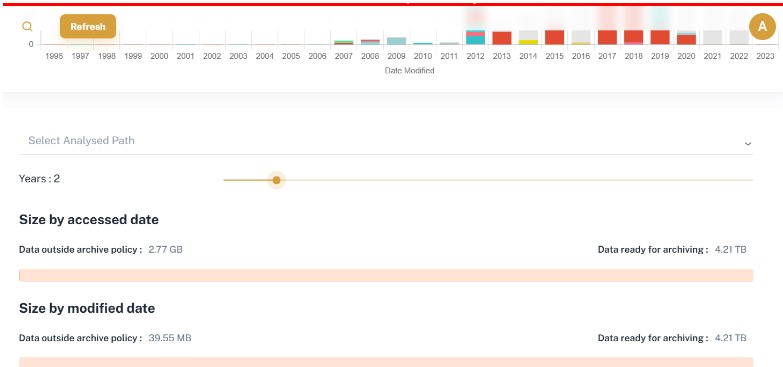In today’s digital age, businesses generate and accumulate vast amounts of data daily—from customer interactions and transactions to internal communications and operational files. This rapid data growth, estimated at around 402.74 million terabytes each day, presents both opportunities and challenges for organizations.
While active data powers day-to-day operations, vast amounts of less-used information quickly fill up storage, driving up costs and complicating data management. A thoughtful approach to long-term data storage is essential to keeping systems efficient and costs manageable.
A data archiving strategy allows businesses to securely store inactive data, freeing up primary storage for active, high-priority information. Let’s explore the key steps in building an effective data archiving strategy supporting sustainable growth and efficient data management.
Step-by-Step Guide to Creating a Successful Data Archiving Strategy
An effective data archiving strategy involves clear steps to ensure data is managed, stored, and accessed efficiently. Each step builds on the previous one, creating a comprehensive approach to long-term data management.
Step 1: Conduct a Comprehensive Data Assessment
Start by thoroughly assessing your data landscape to build an effective archiving strategy. Identify the types of data your organization handles (e.g., transactional, customer, operational) and their volumes.
Classify data based on activity level—whether it’s active, semi-active, or inactive—and analyze access patterns to understand which data is accessed frequently, occasionally, or rarely. Additionally, consider future retrieval needs to ensure that archived data remains accessible when needed.
Step 2: Define Retention Policies and Compliance Needs
ShareArchiver Platform Data AnalyticsEstablishing clear retention policies is essential for regulatory compliance and efficient storage management. Set data retention periods based on data types, regulatory requirements, and industry standards.
Determine timeframes for both data retention and disposal, ensuring that data is held only as long as necessary. Implement a review cycle to periodically evaluate compliance and archiving policies, updating them as regulations and business needs evolve.
Step 3: Choose the Right Archiving Solution
Selecting the right data archiving solution is crucial to support your current and future data needs. Look for a scalable solution that grows with your data volumes. Prioritize solutions that provide robust security features, such as encryption, role-based access, and audit trails, to protect archived data. Advanced e-discovery capabilities are essential for quick and efficient data retrieval, and compatibility with your existing systems ensures seamless integration with current workflows.
Step 4: Develop Data Access and Retrieval Protocols

Clearly define who can access archived data and under what conditions. Set up tiered access controls, granting different levels of access based on user roles to ensure sensitive data is only available to authorized personnel. Establish protocols for data retrieval to maintain data integrity and security, balancing accessibility with control.
Step 5: Establish Data Migration and Backup Procedures
Plan migration paths to move data from primary storage to the archive effectively. Businesses can manage long-term storage expenses while ensuring archived data remains accessible by prioritizing data migration cost efficiency.
Implementing a reliable backup system safeguards archived data from loss or corruption, and setting up periodic migration to updated storage solutions prevents obsolescence, keeping data accessible over time.
Step 6: Implement Monitoring and Optimization Tactics

Automated monitoring helps track archiving processes and ensures the integrity of archived data. Regularly review data access patterns and adjust archiving policies to improve cost-efficiency and system performance. Monitoring also provides insights to adapt policies as storage needs and business requirements change.
Step 7: Train Staff and Promote Awareness
Educate your team on best practices for archiving and data retrieval. Establish clear protocols for managing data in line with the organization’s archiving strategy, emphasizing compliance and data security. By fostering a culture focused on responsible data management, you can ensure consistent adherence to the archiving strategy and maximize its long-term effectiveness.
Following these steps will help you build a solid, adaptable data archiving strategy that supports your organization’s data management goals, ensures compliance, and optimizes resources effectively.
Benefits of a Well-Defined Data Archiving Strategy
A well-executed data archiving strategy directly contributes to a business’s operational success and resilience. Here are the key benefits organizations can achieve by implementing a robust archiving plan:
Enhanced Operational Efficiency
Managing growing volumes of data across multiple departments can be a logistical challenge, leading to inefficiencies and bottlenecks. A well-defined data archiving strategy streamlines this process by categorizing and offloading inactive data, reducing the load on primary storage systems.
This ensures that active data is readily accessible, improving system performance and enabling teams to work more efficiently. With centralized, structured archives, departments can collaborate seamlessly, saving time and resources.
Reduced Risk of Data Loss or Non-Compliance
Data security and compliance are critical for businesses operating in today’s regulatory environment. Failing to manage data retention or disposal properly can lead to fines, legal issues, and reputational damage.
A robust archiving strategy protects sensitive information through secure archive storage solutions, encryption, and controlled access. Additionally, it ensures compliance with industry regulations by adhering to data retention policies and providing a clear audit trail for regulatory inspections.
Improved Disaster Recovery
In the event of a disaster—whether technical, natural, or human-induced—quickly restoring operations is crucial to minimizing downtime and financial losses. A structured data archive serves as a reliable backup, enabling faster recovery with well-organized and easily retrievable data. Businesses can enhance their preparedness further by utilizing specialized disaster recovery software to streamline restoration processes and minimize disruptions.
Common Pitfalls to Avoid in Data Archiving
Without careful planning, organizations can fall into common traps that undermine their success when implementing a data archiving strategy. Here are the key pitfalls to avoid:
Neglecting Scalability Needs
One of the most significant mistakes organizations make is choosing archiving solutions that only address immediate needs without considering future data growth. As data volumes continue to expand, short-term solutions can quickly become inadequate, leading to inefficiencies, higher costs, and the need for frequent upgrades. To avoid this, prioritize scalable archiving solutions that can accommodate growing data volumes seamlessly, ensuring long-term usability and cost-effectiveness.
Inadequate Access Controls
Archiving data without implementing strict access controls can expose your organization to significant risks, including unauthorized access, data breaches, and compliance violations. Failing to define clear access policies leaves sensitive information vulnerable, undermining the integrity of your data archiving system. Establish role-based access controls, enforce strong authentication measures, and regularly audit access logs to maintain a secure archive.
Poor Data Retrieval Planning
A common oversight is neglecting to plan for efficient data retrieval. Archived data often needs to be accessed for audits, regulatory compliance, or operational purposes, and without robust retrieval tools, locating specific files can be time-consuming and costly.
To prevent this, ensure your archiving solution includes advanced e-discovery tools with full-text search capabilities. These tools enable quick and accurate data retrieval, saving time and reducing operational disruptions.
Conclusion
A strategic, long-term data archiving approach is essential for managing growing data volumes, ensuring compliance, and safeguarding business continuity. By following the outlined steps, businesses can optimize storage, enhance security, and streamline data access, driving operational efficiency and resilience.
To implement a reliable and scalable archiving strategy, consult expert solutions like ShareArchiver. With advanced technology and tailored support, ShareArchiver ensures your data is secure, accessible, and future-proof. Request Free Demo to get started.








